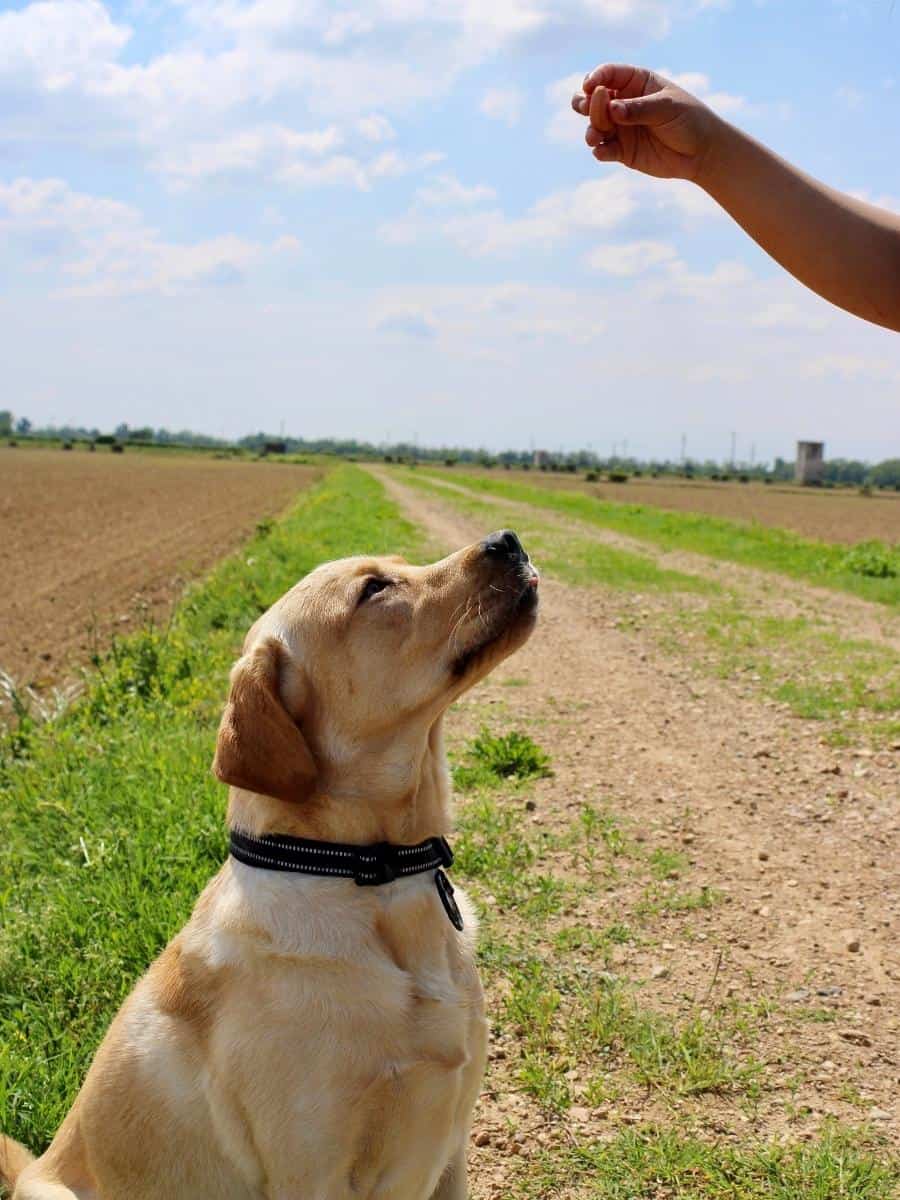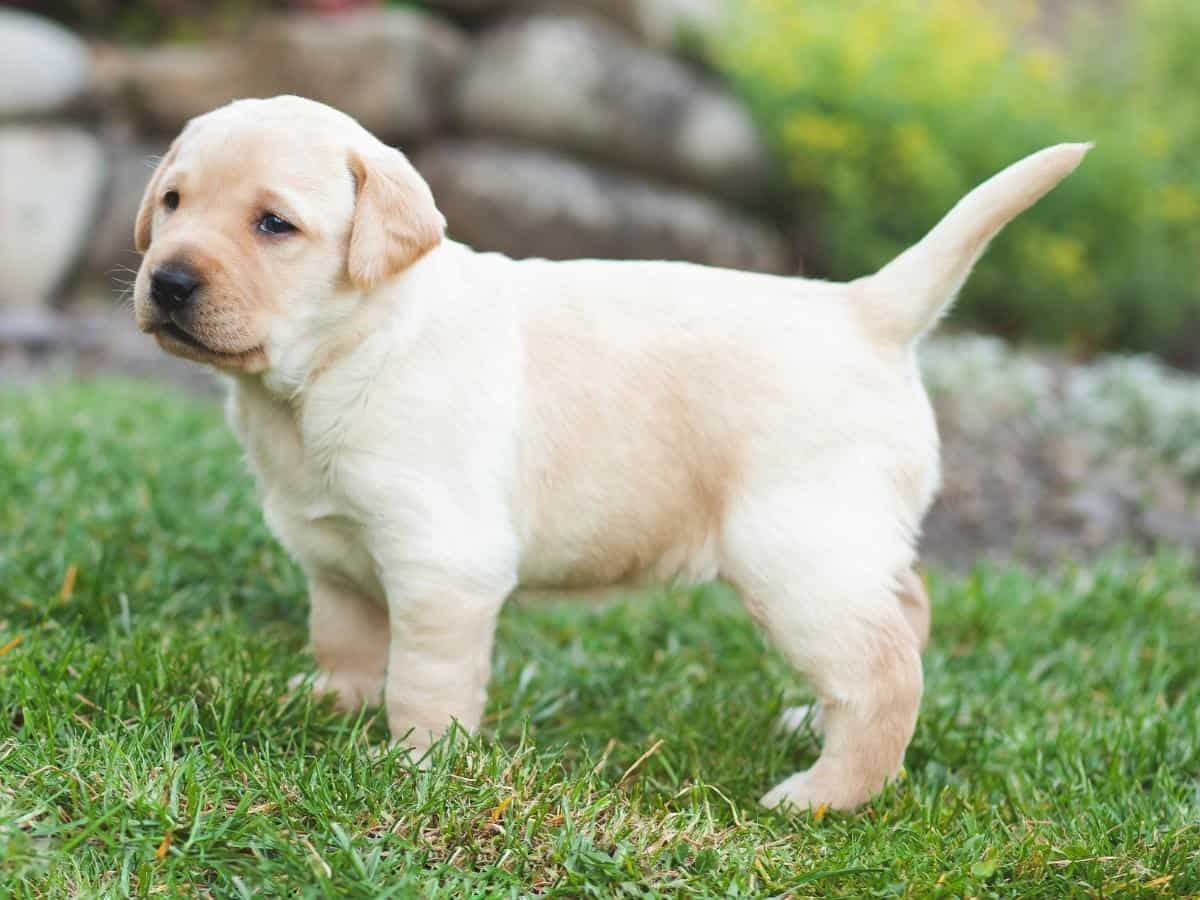Labradors make awesome pets, especially if you fully comprehend the importance of training from a young age. But are you struggling with training your Labrador puppy or contemplating getting a Lab puppy? Does your new Labrador puppy disobey your commands or ignore you?
If you answered yes to any of these questions, here are 7 quick ways how to train a Labrador puppy:
- Start training your Labrador young
- Teach basic commands
- Use high-quality rewards
- Be consistent
- Change up the training environment
- Socialize your Labrador
- Use punishment properly
In this article, you’ll learn the best tips to train your Labrador puppy the right way. I’ll also cover the principles of Lab puppy training, effective positive reinforcement, and the key commands when training your pup.

Labrador Puppy Training
Training your Lab puppy can seem daunting and complicated. There are so many things to consider. What should you do first? To help answer that, I’ve simplified Labrador training so you can get started straight away.
But first...
Gather Your Training Tools
Before starting the learning session, ensure you have all the training essentials to train your Labrador puppy effectively. You will need:
- Crate: When you teach your Labrador puppy the “KENNEL” or “CRATE” command, you’ll need to point at one. Choose a crate big enough for your pup to grow into! A size 42″ is perfect. I recommend a crate with convenience features like double doors, an all-inclusive divider, and a wipeable tray, such as the Midwest Homes for Pets iCrate from Amazon.
- Treats: Get your Labrador puppy some yummy training treats. I love Zuke’s Puppy Naturals from Amazon since they’re soft and only have 3.5 calories per treat, making them ideal for obedience training. I also like to use little pieces of chicken or meat.
- Toys: You can use toys as a reward during training. When teaching your puppy a new command, you may wish to offer him his favorite toy instead of treats. The KONG Puppy Toy from Amazon is one of my favorites as it’s perfect for chewing, chasing, and fetching – and you can even stuff it with food.
- Leash: When it comes to Labrador training, a leash is a must. You can use it to control your pup to obey commands and test his ability to obey while off-leash. For outdoor training and walks, a harness is also an excellent option. Many dog owners find that a harness such as the Julius-K9 works perfectly. I have used this one in the past; however, I now prefer a front-attached harness for even less pull, so I switched to the Walk Your Dog With Love No-Pull Harness.
With your training tools at the ready, you can now proceed to the training steps.
1. Train Your Labrador Young
You should start training a Labrador puppy with basic obedience around eight weeks old, which is generally when they come home. At this young age, Labs can learn basic commands such as sit, come, stay and begin potty training. Learning at this age helps your pup be more confident and relaxed.
Experts in canine behavior agree that you should train your Labrador steadily through puppyhood. Although most dog owners get a new puppy between eight and nine weeks old, the puppy’s social training has already begun.
A good breeder will start early socialization and gentling of their puppies. This study found that puppies exposed to early handling strongly influenced their emotional development and were calmer at eight weeks old.
Young puppies quickly learn from their mother and fellow littermates. For example, they have already started learning their bite inhibition. Mom and siblings will let the pup know when and how much mouth pressure is okay during play or feeding.
It is now your responsibility to continue training your Labrador pup as soon as you bring him home, as early training is crucial for developing and sustaining long-term relationships with humans.
Pro-tip! Don’t train when your pup is tired but let your puppy’s energy guide you.

2. Teach Basic Commands
Every good and well-behaved Labrador you see around should immediately tell you of a well-trained dog. While some people assume that dogs can guess what is in their minds and execute it, this is never true.
Your Labrador puppy relies on your communication to become a well-behaved companion. But you need to train him to decipher the communication codes first.
Most professional dog trainers will tell you to pair a verbal cue with a gesture. This is because body language is a canine’s primary mode of communication, and they have an excellent capacity to read visual cues.
Research has confirmed that coupling your word with contextual information and voice tone has a greater impact on dog obedience.
Basic Commands in Labrador Puppy Training
Most basic obedience training is best done on a leash where you can control your pup and his environment until he has learned to come when called and mastered recall training. Below are the very first commands your Labrador should learn:
- Sit! – The very first command your Labrador puppy learns. It can be on or off-leash and is especially useful when your dog is distracted.
- Stay! – You use this command to train your Lab to stay put and not move, whether on or off-leash.
- Come! – Used to call your Labrador to you and can also be on or off-leash. This cue is especially important should your pup start wandering away from you.
- Stand! – At this command, your dog should change his sitting or lying position to standing.
- Down! – Directs your dog to go down into a lying position. You could combine it with the gesture of lying down with your palm.
- Leave it! – This command teaches your Labrador puppy to avoid picking up items he shouldn’t. It could be your child’s toy or a wild poisonous mushroom.
- Let go! – You are training your Labrador to drop whatever is in his mouth.
- No! – Prohibits your Labrador from doing something or stops his behavior.
- Attention! or Look at me! – This command calls your pup’s attention. He should focus and look at you on the cue. It could be accompanied by a tap of fingers or a vertical pointing finger.
- Kennel/Crate/Bed – Your Labrador should climb into his crate, kennel, or bed.
- Good! – A congratulatory verbal reward that tells your pup he has done well. You may couple it with a treat. It may also be used as “GOOD DOG!” Just be consistent until your Lab can work out that the two have the same meaning.
- OK! – This command gives your dog the go-ahead. He might be looking at you to get the approval to jump in the pond.
Watch How To Teach The First 7 Things To Your Dog In This Video…
Are you looking for a complete guide on basic, intermediate, and advanced training commands? Check out this article, The Essential Labrador Training Commands Guide.
3. Use High-Quality Rewards
Labradors respond best to reward-based training, so you should stock up on treats and toys for high-quality learning. Instead of punishing your Lab for undesirable behavior, you should use positive reinforcement to reward the correct behavior.
Positive reinforcement is training your Labrador by adding a reward to his action – usually the ones you would like him to repeat.
Find out what really motivates your pup, but I’m sure you’ll find that treats are the way to go with your Labrador as they are a very food-motivated breed. Add lots of praise to the correct behavior and make your training sessions feel like a fun game.
Labradors are prone to obesity due to genetics, and since training can be a long process, don’t buy low-quality, high-fat treats.
Zuke’s Puppy Naturals, as mentioned above, are perfectly healthy and low-calorie training treats. I also recommend using your puppy’s kibble from his meal for training. It’s perfectly fine to feed him a meal this way, and many professional dog trainers do the same.
Learn more here; Why Do Labradors Eat So Much? Let’s Science This Thing!
4. Be Consistent
When choosing a word for a verbal cue, you and all family members participating in your Lab’s training need to be sure to use the exact verbiage and try to use the same tone consistently. Choose short cue words to make it easier for your pup to understand.
“Put a sticky note on the refridgerator with all your commands – so everyone is on the same page.”
World of Dogz
Your Labrador is a smart dog, but training takes time. Commit to working with him numerous times a day until he learns the house rules. Train as often as possible to perfect the behavior as training skills will go downhill quickly without routine practice.
You don’t have to use a structured training session to train your Labrador. I’ve found the best way to get my dog to learn new commands is by incorporating them throughout the day – little and often.
It’s far better to train in short 2-3 minutes sessions numerous times daily, rather than fewer 10-minute sessions, and gradually build up week by week.
During each micro-session, work on just one or two commands so that your puppy does not get confused and learns the commands properly.
Best practices for training a Labrador puppy:
- Be patient – Because puppies are so curious, you’ll need a lot of patience when training. However, training becomes much easier once they recognize you as their primary source of treats.
- Don’t rush training – Dogs learn at their own pace, so don’t be tempted to rush your dog if it takes longer than expected. Stay consistent and practice in a distraction-free zone.
- Recap – Take a short break and recap to understand if the command has been learned. Remember to keep training sessions short so your pup does not lose concentration or get frustrated.
- End on a positive note – Always end every training session on a positive note, even if your Labrador puppy failed to learn the command for the day. That might mean a few minutes of play or a game of fetch.
Are you looking for a month-by-month training schedule? Check out this article, Lab Puppy Training Schedule.
5. Vary Your Training Environment
Just because your puppy understands a command in one place, such as your home, doesn’t mean he’ll understand it elsewhere, e.g., in the park, where there are many distractions, such as other dogs and children playing.
To have a well-trained Labrador, you must teach him to obey commands in various situations.
You may have a dog with the best recall ever – in your backyard. But when in the outdoors, and his prey-drive sets in after seeing a squirrel, it’s a different story. The issue is the behavior has not been “proofed,” meaning practicing a command in different environments, so the dog learns the desired behavior, even with tempting distractions.
Once your dog is fluent in a particular behavior, start to teach him in different settings. A few things to note:
- Only change one variable at a time. For example, don’t change the trainer or environment when teaching “SIT-STAY” and aiming for distance.
- Be generous with treats and praise. Work on positive reinforcement to motivate your pup.
- Use higher-value treats. When first trying distractions, use special treats to keep your Labrador’s attention, such as cheese or beefsteak.
- Be realistic with your expectations. Don’t expect immediate success, or you’ll set your dog up to fail. Go slowly and remain calm and patient.
- Proof the trainer. Once your Lab has mastered a command, switch the trainer to see if he’ll perform the behavior for someone else.

6. Socialize Your Labrador
According to scientists, between 2 and 14 weeks is a critical period in a dog’s social development. The socialization and training experiences in this period have lasting effects on the dog’s adult behavior.
A more recent study also found that early puppy socialization, between 3 and 12 weeks, plays a vital role in adult dog behavior. Five-week-old puppies showed a strong fear reaction toward loud noises and unfamiliar environments but eventually figured out which stimuli are dangerous and which are not.
A Labrador puppy will respond better to humans if they have received proper socialization training during this time. Due to insufficient training at this age, some dogs may become untrainable and unapproachable as adults.
Even under different controlled scenarios, research examining dogs’ tendency to “go with the crowd” indicated that they would stick to what they had learned and not conform to other dogs’ behavior.
So, what should you do?
Socialization usually refers to the process of desensitization, which involves progressively exposing a puppy to new experiences, people, sounds, animals, textures, and things that it will face during its life while ensuring that the puppy enjoys the exposure.
Some examples of Labrador puppy socialization:
- Experience of loud noises such as motorbikes, a construction site, or thunder.
- Carry the pup around a supermarket parking lot (before vaccinations).
- Similarly, carry the pup to a busy park.
- Take the puppy to a busy town.
- Exposure to children – in a controlled setting.
- Puppy classes.
- Handling and grooming.
- Leaving your Lab puppy alone.
- Visits to the vet.
- Exposure to bicycles, and skateboards.
- Take a car ride.

7. Use Punishment Properly
While training can be fun, starting by weeding out bad behavior while your dog is still young is better. Most Labrador behavior problems result from incomplete training, misunderstanding, boredom, or lack of stimulation and exercise.
Thankfully, bad behavior can be easily managed and corrected by distracting and redirecting your puppy from poor behavior. Use rewards-based training and ignore demanding behavior such as demand barking or jumping up.
Labrador puppy training mistakes:
- DON’T use physical punishment.
- DON’T yell at your Labrador.
- DON’T rub your pup’s nose in his dirt!
- DON’T encourage bad behavior.
- DON’T reward your Lab’s negative behavior in remorse.
- DON’T use shock collars.
It is counter-productive to hit or yell at your Labrador as it only causes him to be fearful and even discourages him from learning the command in the first place. Yelling and losing your cool frightens and confuses the dog. Using aversive training methods also causes distrust and can lead to aggression.
If you’re a regular reader of my blog, you’ll know that I advocate positive reinforcement training and disapprove of aggressive methods such as shock collars.
This recent study on the effectiveness of dog training with shock collars found that training with positive reinforcement was more effective and offered fewer risks to dog welfare and the strength of the human-canine bond.
Learn more here, How to Discipline a Labrador.
How Long Does It Take To Train A Lab Puppy?
It takes 2 to 3 months to train a Labrador to learn basic obedience commands. Usually, most 20-week-old Lab puppies are potty trained, crate trained, and understand a few basic commands if you’ve trained them properly.
Crate training is advised but it will take 2-3 days for your puppy to enter the crate on their own. Introduce the crate gradually, and don’t try to force it. Do you want to know how to crate train your Lab? Check out my step-by-step guide, Easy Labrador Puppy Crate Training.
If you follow my 7 tips above and remain consistent with your training, you’ll have the basics covered in no time. You can then progress to advanced Labrador puppy training, which brings me onto the net section.

Advanced Labrador Puppy Training
With time, as your puppy advances into adulthood, he’ll need training in the following advanced commands:
- Jump! – Train your Labrador to jump over a fence, wall, barrier, etc.
- Fetch! – You train your puppy to bring an item to you.
- Heel! – Your dog learns to walk closely by your left side, on or off-leash.
- Touch! – You teach your pup to touch his nose or paw to an item – known as targeting. E.g., teach your Lab to touch your hand.
- Track! – Trains your Lab to track a person or an object. Especially useful for working dogs.
- Speak! – You train your dog to bark or be vocal. Maybe there is an intruder, and you want your dog to scare them away. Although Labs are super friendly, the trespasser might not know this!
- Quiet! – Directs your dog to stop barking at a visitor or other stimulants.
- Spin! – Train your dog to go around in a circle.
- Crawl! – You teach your Lab to crawl on command. Often used as a fun trick.
- Guard! – Trains your Labrador to keep watch at the door or be alert around an item.
- Go ahead! – Your Lab will learn to stay ahead of you. It is often used in agility competitions.
FAQs on Labrador Puppy Training
Labradors are easy to train due to their high intelligence, stamina, friendliness, and strong desire to please. As working hunting dogs bred to retrieve duck and game, they have endless energy and love having a job to do, making them excellent learners.
All Labradors are easy to train and no specific color from yellow, black, or chocolate is any harder. There is no scientific evidence to say that color impacts trainability and any suggestion that chocolate Labs are harder to train is down to preconceived bias.
This study on the association of Labrador Retrievers’ coat color and behavior found that no particular color was easier to train, more hyperactive, or aggressive.
Let’s Wrap This Up!
If you’re eager to start, you can speed up your Labrador’s training by using the correct method, which is positive reinforcement training.
However, training your Labrador is an ongoing experience that lasts for years. You’ll be able to teach him to do the basics in a few months, but remember never to give up on training and make it a fun experience for you both instead of a chore.





